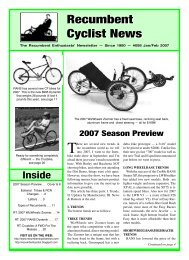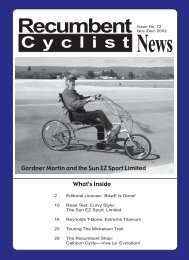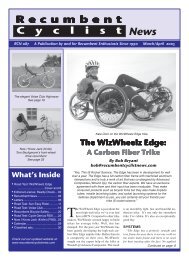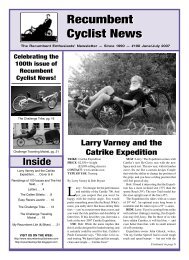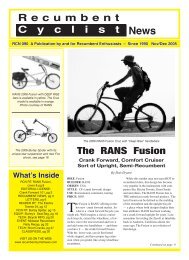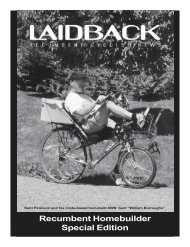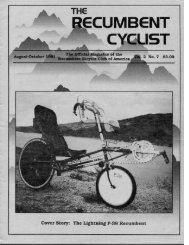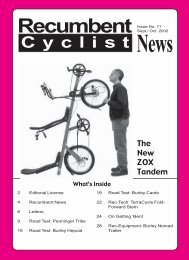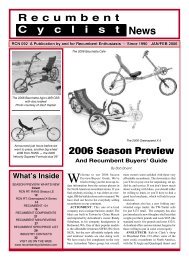In This Issue - Steve Briggs
In This Issue - Steve Briggs
In This Issue - Steve Briggs
Create successful ePaper yourself
Turn your PDF publications into a flip-book with our unique Google optimized e-Paper software.
The Cannondale Recumbent<br />
by Bob Bryant<br />
Cannondale is known for cutting-edge, high-tech, and cool products.<br />
For the 2002 season, they now offer a very cool new CLWB recumbent<br />
called the Easy Rider. We’ve been hearing rumors about a Cannondale<br />
recumbent for years, and now, for the first time ever, they’re in production<br />
and available at your local (hopefully) Cannondale or recumbent<br />
dealer.<br />
Cannondale is not acting like a lame wedgie manufacturer. They’ve<br />
carefully crafted a very nice recumbent, and we may see others in the<br />
future. Cannondale handcrafts their bikes in the USA out of custom<br />
oversized aluminum tubes. The frames are stiff and strong. They also<br />
have the capability to be light (though the Easy Rider is no lightweight).<br />
I’m really jazzed about this new bike. The systems, fabrication quality,<br />
components (most of them), design, testing, and integration will<br />
set new standards for the recumbent industry. <strong>This</strong> is the most finely<br />
crafted recumbent I’ve reviewed in 12 years. Performance and handling<br />
are also at the top of their design category. I truly hope that<br />
Cannondale takes their design talents and building capabilities into all<br />
realms of recumbency. Also, the service and response I got from the<br />
company during this test were among the best, if not the best, I’ve<br />
received.<br />
History<br />
<strong>This</strong> CLWB is not a mountain bike. It’s perfect for varied terrain, including<br />
paved roads, unpaved roads, rail-trails, dirt roads, etc., but<br />
Cannondale believes that showing the recumbent flying through the<br />
air as an MTB is irresponsible.<br />
RCN’s history with Cannondale dates back several years. <strong>In</strong> 1986<br />
we met Cannondale’s David Campbell at <strong>In</strong>terbike in Las Vegas. At<br />
that time, Cannondale had a secret prototype LWB ASS 26/20 fullsuspension<br />
recumbent, and they wanted some feedback from enthusiasts.<br />
David told us that when they had news, they’d call. Sure enough,<br />
back in August 2001 we received a call telling us that the Easy Rider<br />
was about to be unveiled.<br />
The chief designer on Cannondale’s team is Chris Dodman. Chris<br />
lives in Ireland (hence the Euro feel of this CLWB), is connected with<br />
the HPV movement, and has even shown Cannondale prototypes at<br />
European HPV events.<br />
6 Recumbent Cyclist News No. 69<br />
Recumbent Design, the Cannondale Way<br />
Cannondale has over 10 years of high-end suspension experience and<br />
insight. Besides beating the living crap out of test bikes, they also use<br />
sophisticated motion analysis software. The suspension is tested over<br />
the equivalent of 40,000 miles of riding (the bicycle’s statistical<br />
lifespan). Roughly 95% of the bikes will outlast this figure. Of 100<br />
bikes, maybe one will break.<br />
The bikes are road- and robot-tested using a variety of methods. What<br />
these methods all have in common is the use of a data acquisition box.<br />
<strong>This</strong> is very similar to what is used by the auto industry and for race<br />
cars and exactly what Cannondale used while designing their Supercross<br />
motorcycle. Cannondale’s system uses a strain gauge and records eight<br />
different items at once—up to 1,000 times per second. There is a series<br />
of static, load, strength, and durability testing for just about every aspect<br />
of the bike. No recumbent has ever undergone testing this serious.<br />
Sound too high-tech to you Well, maybe—I had to have it explained<br />
to me by two people over a few conversations.<br />
The part I did understand right away was the real-world testing.<br />
Before the testing phase was complete, 300-pound test riders rode the<br />
wheels off of the Easy Rider.<br />
I have to admit, I was still skeptical, even when I sat down on production<br />
model #001 here in Port Townsend. The shock sinks a bit as<br />
you sit down on the seat. I’m thinking “here we go again . . . pogo<br />
city.” I’d warned the guys at Cannondale about this. They assured me<br />
that if need be, there were 10 different coil/oil shock combinations.<br />
Hey, they even say the suspension is “bob-free.” I’m not sure what that<br />
means.<br />
So I hit the road. It was a nasty late-December day, and I rode the<br />
bike on my test loop in what I would find out later were gusts of up to<br />
50 mph. The Easy Rider handled it with ease. I rode up the two biggest<br />
hills. The suspension is active, but no pogo . . . “bob-free.” That’s when<br />
I figured out that they were right: this is the finest recumbent suspension<br />
I’ve ever tried.<br />
Systems<br />
Frame—The Easy Rider has a Cannondale Advanced Aluminum Design<br />
(CAAD) aluminum frame. Different diameters and wall thicknesses<br />
are used to reinforce crucial areas for strength and lateral stiffness and<br />
to make the frame as light as possible. The Easy Rider CAAD frames<br />
are welded and heat-treated by hand in Bedford, Pennsylvania. The<br />
build procedure they use is called “just-in-time,” which allows them to<br />
make running changes in the design relatively quickly.<br />
Each frame is painted with DuPont Imron, and there is a clearcoat<br />
over the decals. The paint quality is the best we’ve ever seen on a<br />
production recumbent and rivals custom paint jobs.<br />
Fork—Cannondale’s HeadShok is one of the finest front suspensions<br />
I’ve ever ridden. I rode one of the first many years ago. We have<br />
also owned a Cannondale HeadShok-equipped MTB. The HeadShok<br />
is vastly superior to any 20-inch BMX suspension fork. Each HeadShok<br />
has 88 needle bearings for stiction-less travel. The fork, suspension<br />
parts, and headset are all an integral system. The front suspension has<br />
60 mm of travel.<br />
Suspension—Cannondale’s rear suspension is also based on years<br />
of experience, engineering, and rigorous testing. The aluminum swing<br />
arm is similar to those found on the Jekyll— evolved and optimized<br />
from it’s roots on the Super V. The shock is a Fox Vanilla coil/oil.<br />
Riders will find that it’s much more lively and has far more active<br />
travel than other recumbent suspensions. The rear suspension has 75<br />
mm of travel.<br />
Steering—Cannondale’s Easy Riser stem/riser/bar combination is<br />
well thought out and expertly crafted. The bars are tourist-style upright<br />
bars. With the adequate pullback of the stem, the reach will be<br />
suitable for most.<br />
Cannondale tried stems ranging from 0 to 100 mm. The bike has a<br />
70 mm stem. I found the reach perfect for a relatively upright mode,<br />
but I experienced borderline hyperextension when I reclined the seat<br />
farther back. Cannondale offered me the chance to try out their prototype<br />
100 mm stem. There is some benefit to the longer stem, but the<br />
handling is optimized with the one they chose. Perhaps at some time in<br />
the future Cannondale will offer options for stem length. It would also<br />
be very easy to choose longer-reach handlebars given their top-loading<br />
style of stem.<br />
The handlebar feel is different from other CLWB’s. The Easy Rider’s<br />
pedals are a bit higher than on other similar CLWB’s. <strong>This</strong> makes knee<br />
clearance between the bars a minor concern (for some). The bike has a<br />
very European feel, no doubt due to the design talents of one of the<br />
design team members, Chris Dodman. The ergonomics are very good.<br />
The only thing newbies will need to know is that you sometimes have<br />
to tuck your knee out of the way of the bars in tight turning situations.<br />
Weight—The Easy Rider is not a lightweight by any stretch.



